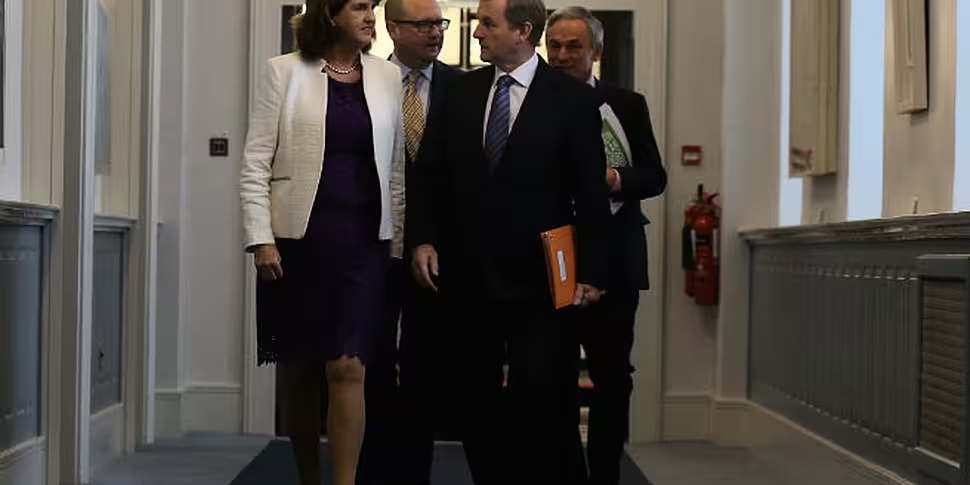The Troika is no more. No, not that Troika (the IMF/EU/ECB haven’t gone away; they’re still here checking us out twice a year), the other one: the (un)Holy Trinity of Fianna Fáil, Fine Gael and Labour. The three parties have utterly dominated Irish politics for the best part of a century. There have been brief interlopers in that time, but while the likes of Clann na Poblachta, Clann na Talmhan, the PDs and the Greens have come and gone, the big three have maintained their stranglehold on politics. Until now. Thursday’s Irish Times opinion poll showed their combined strength at just 46%. That’s half what they were getting thirty years ago. A majority of voters have now decided that after 90 years of the two and a half party system, for now at least, they’d prefer somebody else thank you very much. One in three voters are planning to vote for independents or ‘others’, while Sinn Féin, at 22%, is the biggest party. It’s an extraordinary fall from grace for the political establishment. And it raises massive questions about the next Dáil and whether or not it’ll be possible to put a government together.
If those figures were replicated in a general election (and, to be fair, that’s a big ‘if’), Fine Gael would be down well below 30 seats; Fianna Fáil would be somewhere between 30 and 40, while Labour would be reduced to single figures. Conceivably, the three between them wouldn’t have enough seats to form a majority coalition government.
That’s hardly likely to actually happen when push comes to shove and the electorate has to get down to the business of voting in a government. But that we’re even talking about such a scenario shows how radically Irish politics has changed. The combined strength of the three parties might not be as low as 46 percent come the next election, but it would be brave punter who would bet on it being much in excess of 60 percent. It’s hard to imagine that Independents will take 32% of the vote in that election. The strong support for ‘others’ is undoubtedly a reflection of voters’ disillusionment with political parties. When voters actually have to pick who they want to govern for the next four or five years, will one in three of them decide that their local independent candidate is the best option? Probably not, but it seems clear that a sizeable proportion – certainly bigger than in any previous election – will go for independents. There may not be 50 of them as TDs when the votes are counted, but in every constituency in the country, an independent will be in the shake-up for a seat.
It’s true the 32 per cent is spread across a wide variety of independents who hail from the right, left and centre of the political spectrum. But even allowing for those differences, there is a very real possibility that the next government will include a grouping of independents for the first time since the 1950s, with the possibility of one or more of them at the cabinet table.
Given the hugely negative publicity surrounding the Mairia Cahill case, Sinn Féin will be happy with their 21 percent, despite the two point drop in support. The party’s tactics in recent weeks – including the Dáil sit-in by Mary Lou McDonald and her hugely controversial naming of names on Wednesday – seem to be about tapping into the ‘anti-establishment’ mood that exists among a sizeable section of the electorate. It mightn’t be to everyone’s taste – the naming of former senior politicians as alleged holders of Ansbacher accounts, based on the flimsiest of evidence, sets a hugely dangerous precedent – but that won’t bother Sinn Féin in the slightest. It’s clear the party is willing to do whatever it takes to maximise its vote in the next general election.
It’s a sign of how the mighty have fallen that Fianna Fáil will be reasonably happy with its poll showing. Its 21% is almost certainly less soft than Sinn Féin’s 22%, given that the latter traditionally falls short of its opinion poll rating in actual elections. If anything the local elections suggest Fianna Fáil’s support is being understated in opinion polls. Even allowing for that though, the realistic target for Fianna Fáil next time is 35-plus seats. It might horrify the traditionalists in the party but that would represent progress from the 2011 nadir. Michéal Martin’s media skills might also prove a considerable asset in a wide open general election campaign where many voters will only make up their minds late in the day.
That leaves the two government parties. The worry for them is that, as happened to governments in 1977, 1987 and 2011, voters have made up their minds that they don’t like the coalition. Once that sets in, it’s almost impossible to shake.
Another couple of polls such as this and the pressure would really intensify on Enda Kenny’s leadership. Then again, Labour’s rating demonstrates that changing leader brings no guarantees of better performance.
This poll should, at least, bring an end to the nonsense being talked by some in government circles about going to the country early – perhaps after next October’s budget. The Coalition’s best (only?) chance is to cut down on the silly mistakes it has been making; lower the self congratulatory tone it has been guilty of adopting since assuming office and hold off the election for as long as possible in the hope that the improving economy has an impact and softens the attitudes of voters.
But, as of now, it would take a miracle for the coalition to be returned. That said, the prospect of a Fine Gael-Labour government seems no more unlikely than any of the other potential combinations. The decline of the “Troika” means all bets are off for the next election.









